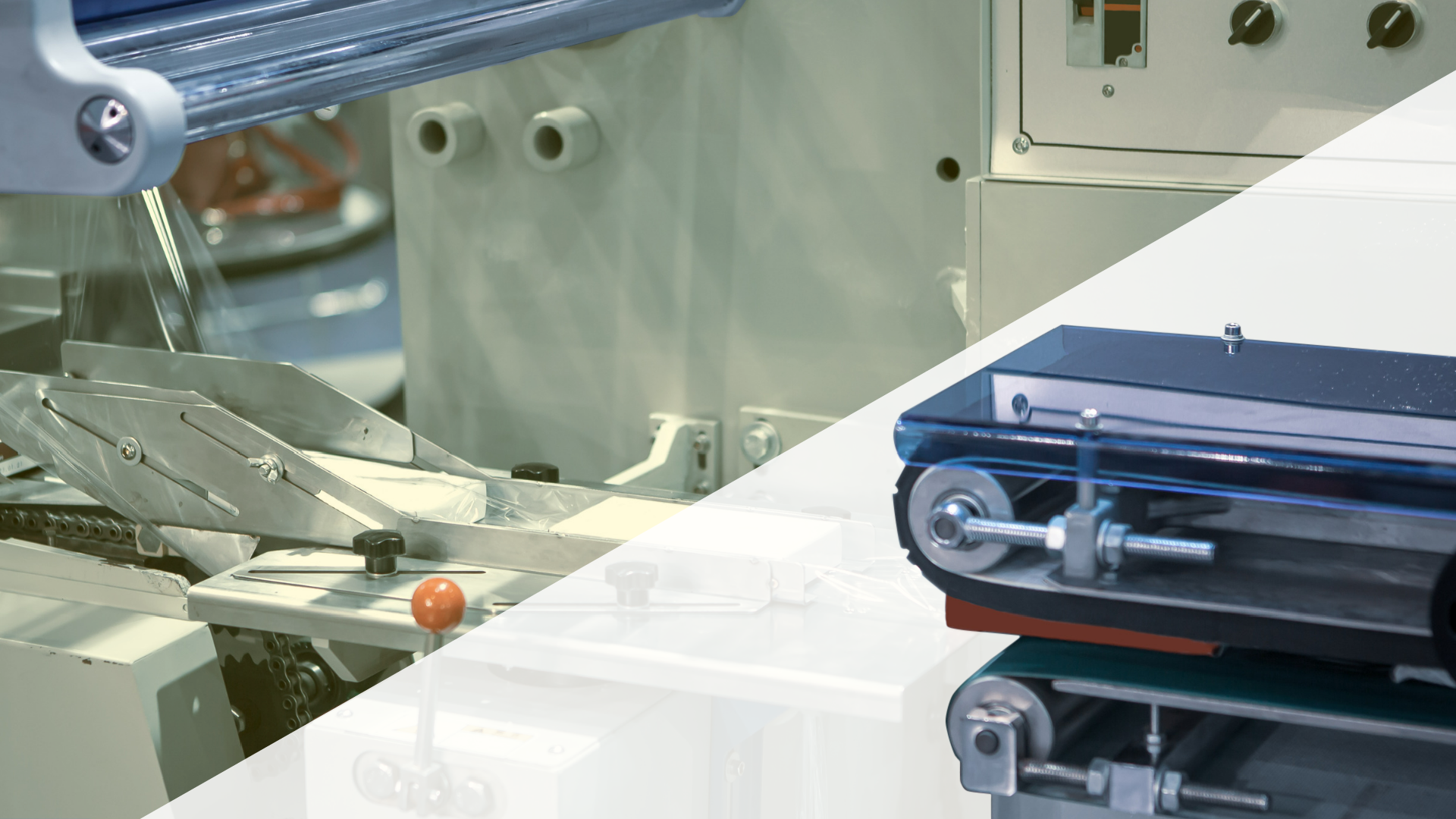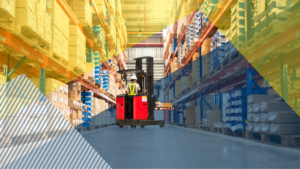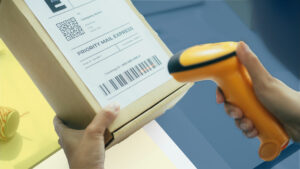Flow wrapping and overwrapping are two commonly used packaging methods for consumer goods. In addition, shrink wrapping, blister packaging, and other techniques are widely used across manufacturing, fulfillment, and shipping; their usage varies depending on the product, industry, and purpose. Let’s take a look at how these packaging methods stack up, and when to use each one.
What Are Some of the Most Commonly Used Packaging Methods?
Overwrapping
- Description: Film is folded and sealed around the product or bundle.
- Common Uses: Cigarette packs, tea boxes, and multi-pack items.
- Advantages: Enhances shelf appeal and offers tamper resistance.
What Are The Steps Involved In Adding Overwrap Packaging To A Product?
Adding overwrap packaging to a product involves carefully wrapping a product or bundle with a film (often polypropylene or polyethylene), folding it neatly, and sealing it. Overwrapping is commonly used for boxed items, multi-packs, and high-end products for a polished finish. Below are the typical steps:
- Prepare the Product
- Inspect the Product and ensure it is clean, free of dust, and ready for wrapping.
- If bundling multiple products, align them properly for consistent wrapping.
- Select the Overwrap Material
- Opt for materials like BOPP (biaxially oriented polypropylene) or heat-sealable cellophane.
- Decide between clear, printed, or branded film depending on product and marketing needs.
- Loading the Wrapping Machine
- Set Up the Film Roll. Load the selected film onto the overwrapping machine.
- Calibrate machine settings for product size, film thickness, and speed of operation.
- Wrapping the Product
- The machine or operator draws the film around the product.
- For automatic machines, film is precisely measured and cut to fit.
- The film is folded neatly around the edges and bottom, similar to wrapping a gift.
- Excess film is trimmed or tucked to avoid bulkiness.
- Sealing the Film
- Heat is applied to seal the overlapping edges of the film.
- Ensure consistent, clean seals without wrinkles or burn marks.
- A perforated strip may be added to the seal for easy opening.
- Cooling and Smoothing
- Allow the sealed film to cool and set, ensuring a snug and wrinkle-free fit.
- Machines may use brushes or rollers to smooth the film for a polished appearance.
- Inspection and Quality Control
- Check the overwrap for:
- Even seals and neat folds.
- Correct positioning of printed or branded elements.
- No damage to the product or film.
- Check the overwrap for:
- Secondary Operations (Optional)
- Apply stickers or additional branding if required. (Labeling)
- Group multiple overwrapped items for distribution or sale. (Bundling)
- Packing and Distribution
- A conveyor carries the finished items to be stored or packaged further. Place the overwrapped products into boxes or onto pallets for shipping or storage.
What Are The Advantages Of Overwrapping:
- Enhanced Appearance: Provides a premium, polished look.
- Tamper Resistance: Offers a layer of security against tampering.
- Moisture and Dust Protection: Keeps products clean and fresh.
- Eco-Friendliness: Often uses less material than shrink wrapping.
Flow Wrapping
- Description: Products are continuously wrapped in film, with seals on the back and ends.
- Common Uses: Candy bars, cookies, and small hardware.
- Advantages: Fast, cost-effective, and provides protective packaging.
How Are Products Flow Wrapped, From Start To Finish?
Flow wrapping, also known as horizontal form-fill-seal (HFFS), is a packaging process where a product is continuously wrapped in a protective film that is sealed and cut to create individual packs. Here’s a step-by-step guide:
- Product Preparation
- Ensure the product is clean, defect-free, and ready for packaging.
- Products are typically placed on a conveyor for smooth feeding into the flow wrapper.
- Film Loading
- Choose a suitable material (e.g., polypropylene, polyethylene) based on the product’s size, shape, and shelf-life requirements.
- Place the roll of film onto the flow wrapping machine. The film unwinds and feeds into the machine’s forming area.
- Forming the Film Around the Product
- The film is shaped into a tube around the product by a forming collar.
- The product moves through this collar, ensuring the film surrounds it.
- The film’s edges meet beneath the product, ready for sealing.
- Sealing the Film
- The machine seals the film’s overlapping edges along the length of the product using heat or adhesive.
- This creates a tight and secure seam along the back.
- The product, now encased in the film tube, moves to sealing jaws or rollers.
- These jaws seal the open ends of the film and cut between products to separate them.
- Cutting and Individual Wrapping
- A blade integrated with the cross-sealing jaws separates the continuous flow of wrapped products into individual packages.
- The machine ensures precise cutting for consistent package sizes.
- Inspection and Quality Control
- Proper sealing (no gaps or leaks).
- Accurate alignment and tight wrapping.
- Clear or correctly printed branding if using pre-printed film.
- Secondary Operations (Optional)
- Apply batch numbers, expiration dates, or barcodes using inline printers.
- Attach additional labels if required.
- Packing and Distribution
- The flow-wrapped items are often grouped or boxed for transportation.
- They are packed into cartons or cases for shipping and retail.
Advantages Of Flow Wrapping
- Speed: High-speed automation wraps products quickly, ideal for large-scale production.
- Flexibility: Works for various shapes and sizes, including irregular items.
- Tamper Evidence: Sealed packages deter tampering and maintain hygiene.
- Cost-Effectiveness: Minimizes material waste and labor costs.
Shrink Wrapping
- Description: Heat is applied to a plastic film that shrinks and conforms tightly around the product.
- Common Uses: Electronics, books, multi-packs (e.g., soda cans), and perishable food.
- Advantages: Tamper-evident, secure, and protects against dust and moisture.
How Is Shrink Wrapping Applied To A Product?
Shrink wrapping involves several systematic steps to tightly seal a product or bundle with a heat-shrinkable plastic film. Here’s a breakdown of the process:
- Product Preparation
- Ensure the product is clean and dry.
- Place the product in the desired orientation for packaging.
- Film Selection and Loading
- Choose the appropriate shrink film:
- Common materials: Polyethylene (PE), Polypropylene (PP), or Polyvinyl Chloride (PVC).
- Selection depends on product size, shape, and protection needs.
- Load the shrink film roll onto the wrapping machine or manually position it for smaller-scale operations.
- Choose the appropriate shrink film:
- Wrapping the Product
- For automated systems: The film wraps around the product and seals it along the edges.
- For manual or semi-automatic systems: The operator positions the product on the film and folds the film around it.
- Sealing the Film
- Use a heat sealer (manual or automatic) to bond the film edges together.
- Common seal types:
- L-Seal: Wraps all sides with a continuous seal.
- Center Seal: Common in flow-wrap-style shrink systems.
- Shrinking the Film
- Apply heat to shrink the film tightly around the product
- Pass the product through a shrink tunnel (an oven-like chamber with controlled heat).
- Alternatively, use a heat gun for smaller or irregular items.
- The heat causes the film to contract and conform tightly to the product’s shape.
- Cooling and Final Inspection
- Allow the product to cool, solidifying the film in its final form.
- Inspect the package to ensure:
- The film has shrunk evenly without tears or bubbles.
- The seals are strong and intact.
- Secondary Operations (Optional)
- Add branding or informational labels if required.
- Group multiple shrink-wrapped items for shipping or retail.
- Packing and Distribution
- Package the shrink-wrapped products into boxes or onto pallets for transport or storage.
Advantages Of Shrink Wrapping
- Protective Layer: Shields against dust, moisture, and tampering.
- Compactness: Reduces packaging bulk.
- Customization: Allows clear or printed film for branding.
Skin Packaging
- Description: A vacuum draws heated film tightly around the product and secures it to a rigid backing.
- Common Uses: Tools, hardware, and certain foods (e.g., fish or meat cuts).
- Advantages: Secures product position and offers good visibility.
What Are the Steps Involved In Skin Packaging?
Skin packaging, sometimes referred to as vacuum skin packaging (VSP), involves using a flexible plastic film that tightly conforms to a product’s shape when a vacuum is applied. The product is typically mounted on a rigid backing board or tray. Here’s a detailed step-by-step guide to the process:
Skin packaging, sometimes referred to as vacuum skin packaging (VSP), involves using a flexible plastic film that tightly conforms to a product’s shape when a vacuum is applied. The product is typically mounted on a rigid backing board or tray. Here’s a detailed step-by-step guide to the process:
- Product Preparation
- Inspect the Product and ensure it is clean, dry, and free of debris.
- Place the product on a rigid backing material, such as a cardboard sheet, plastic tray, or specialized skin board.
- Backing materials may be pre-printed with branding or product information.
- Film Selection and Loading
- Select a heat-sensitive, stretchable film compatible with the product and backing material.
- Common materials include polyethylene (PE), polyvinyl chloride (PVC), or multi-layer films.
- Place the film roll onto the skin packaging machine and ensure it is properly threaded through the system.
- Select a heat-sensitive, stretchable film compatible with the product and backing material.
- Heating the Film
- The machine heats the film to make it pliable and stretchable.
- Heating softens the film to ensure it conforms closely to the product’s contours.
- Vacuum Application
- The product and backing material are positioned beneath the heated film in a vacuum chamber.
- The chamber’s vacuum system removes air between the product, film, and backing material.
- The vacuum pulls the softened film tightly over the product and secures it to the backing.
- Sealing the Film
- The film is bonded to the backing material using heat and pressure.
- This creates an airtight seal around the product, ensuring durability and protection.
- The film is bonded to the backing material using heat and pressure.
- Cooling and Trimming
- Allow the sealed product to cool, solidifying the film’s shape around the product.
- Excess film around the edges is trimmed to create a clean, polished package.
- Inspection and Quality Control
- Check for a tight, uniform film application with no air bubbles or wrinkles.
- Proper alignment of printed elements (if any).
- Secondary Operations (Optional)
- Apply additional labels or stamps for branding or regulatory information.
- Pack skin-packaged items into boxes or shipping containers.
Advantages Of Skin Packaging:
- Product Protection: Provides a secure fit, minimizing product movement during transport.
- Enhanced Visibility: The clear film showcases the product while protecting it.
- Tamper Evidence: Offers strong seals that are hard to open without visible damage.
- Versatility: Suitable for various products, including hardware, tools, seafood, and meats.
Vacuum Sealing
- Description: Removes air from the package before sealing it, creating a vacuum.
- Common Uses: Perishable foods (e.g., meat, cheese), electronics, and medical equipment.
- Advantages: Extends shelf life, reduces contamination risk, and minimizes bulk.
How Are Product Vacuum Sealed?
Vacuum sealing is a process that removes air from a package and seals it tightly to protect the product from moisture, contamination, and oxidation. It is commonly used for food preservation, medical products, and industrial components.
- Product Preparation
- Ensure the product is clean, dry, and free of contaminants.
- Choose a vacuum-sealable bag or pouch made from multi-layered materials that are air-impermeable.
- Loading the Product
- Ensure the product fits snugly within the bag, leaving enough open space at the top for sealing.
- For liquid-rich foods (e.g., soups or marinated items), use specialized vacuum bags to prevent liquid from being sucked into the machine.
- Positioning the Bag in the Vacuum Sealer
- Insert the open end of the bag into the vacuum sealing machine’s sealing chamber or nozzle.
- Ensure the bag is flat and wrinkle-free at the sealing area to ensure a strong, airtight seal.
- Air Removal
- Activate the vacuum sealer. The machine removes air from the bag, creating a vacuum environment.
- The entire bag is placed inside a chamber, and air is evacuated from both the bag and the chamber for consistent results.
- The bag remains outside the machine, and air is removed through a nozzle inserted into the bag.
- Activate the vacuum sealer. The machine removes air from the bag, creating a vacuum environment.
- Heat Sealing
- Seal the Bag:
- Once the air is removed, the machine seals the open end of the bag using heat.
- The heat melts the inner layer of the bag, bonding it to create a hermetic seal.
- Seal the Bag:
- Cooling and Inspection
- Let the heat-sealed area solidify before handling the bag.
- Inspect the Packaging and check for:
- A tight vacuum fit around the product.
- A strong, continuous seal with no gaps or wrinkles.
- Secondary Operations (Optional)
- Add labels for product identification, expiration dates, or barcodes.
- Package multiple vacuum-sealed items into cartons or boxes for storage or transport.
- Storage and Distribution
- Store the vacuum-sealed product appropriately based on its nature:
- Food Items: Refrigerate or freeze for extended shelf life.
- Non-Food Items: Store in dry, clean environments.
- Store the vacuum-sealed product appropriately based on its nature:
Advantages Of Vacuum Sealing:
- Extended Shelf Life: Reduces exposure to oxygen, slowing spoilage and preserving freshness.
- Protection: Shields products from contaminants, moisture, and pests.
- Compact Storage: Removes air, reducing package size and maximizing storage efficiency.
- Versatility: Suitable for a wide range of products, including food, electronics, and medical supplies.
Other Packaging Types
Blister Packaging
- Description: A pre-formed plastic cavity (the “blister”) holds the product, sealed onto a backing material, typically cardboard or foil.
- Common Uses: Pharmaceuticals (e.g., tablets and capsules), batteries, and small consumer goods.
- Advantages: Offers visibility, tamper resistance, and protection.
Cartoning
- Description: Products are placed into pre-formed cardboard boxes or cartons.
- Common Uses: Cereal, frozen meals, cosmetics, and consumer electronics.
- Advantages: Provides structure, branding, and product protection.
Clamshell Packaging
- Description: Rigid plastic containers that fully enclose a product, often hinged or snap-closed.
- Common Uses: Tools, electronics, and food items like salads or fruit.
- Advantages: Durable, tamper-evident, and enhances visibility.
Flexible Packaging (Pouches and Sachets)
- Description: Uses lightweight materials like plastic, foil, or paper for pouches or bags.
- Common Uses: Snacks, sauces, beverages, and single-serve food items.
- Advantages: Lightweight, portable, and reduces material waste.
Aseptic Packaging
- Description: Sterilized products are packed in sterile environments using sterilized materials.
- Common Uses: Shelf-stable beverages (e.g., milk, juice), soups, and sauces.
- Advantages: Extends shelf life without refrigeration and ensures product safety.
Bottling and Capping
- Description: Products are filled into bottles and sealed with caps or lids.
- Common Uses: Beverages, pharmaceuticals, and liquid cosmetics.
- Advantages: Provides excellent product protection and branding opportunities.
Stretch Wrapping
- Description: Stretchable plastic film is wrapped around items, often on pallets, for shipping and storage.
- Common Uses: Bulk goods, warehouse logistics, and large shipments.
When Should Flow Wrap vs Overwrap Packaging Be Used?
While both Overwrap and Flow Wrap packaging typically use oriented polypropylene (BOPP) film to wrap a product, there are distinct differences in how the two types of packaging are used—as well as the suitable products, machinery, and the steps involved in the product of each.
What Is Flow Wrapping?
Flow wrapping, also known as horizontal bagging, fin-seal wrapping, pillow-pouch wrapping, or crimp-seal wrapping, is a horizontal-motion packaging procedure wherein a product (or a sample product and leaflet) is wrapped in transparent or printed polyethylene (PE), polypropylene (PP) or polyethylene terephthalate (PET) packaging. The finished product features a crimped seal on each end.
Flow wrapping is typically used in the food and beverage and pharmaceutical industries to package products like soap, lotion, and candy bars. Flow wrap packaging is ideal for companies wanting to distribute samples of their products in sealed packaging, along with additional information (like a literature card).
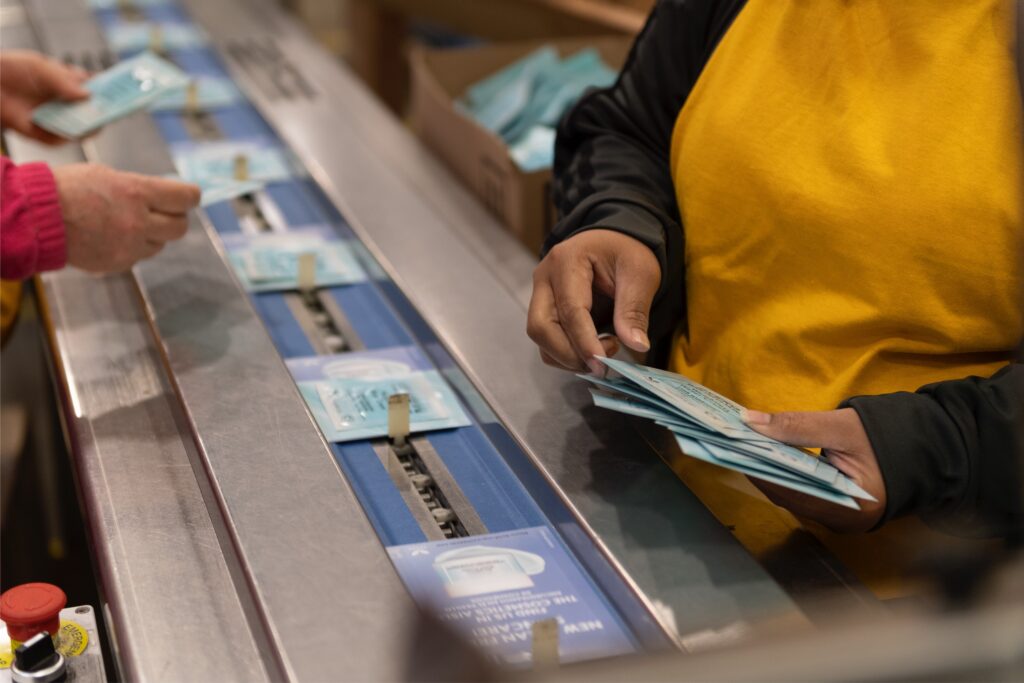

When Should Flow Wrapping Be Used?
Flow wrapping is often chosen when an airtight seal is needed. It is often used to wrap coupons, affiliate marketing items, product samples, mailers, candy, baked goods, or any solid item that needs to be put in a bag.
Benefits of flow wrapping a product:
- Airtight Seal: The airtight seal that results from flow-wrapped products gives it a longer shelf life and helps protect it from harmful external contaminants.
- Product Size Versatility: Because flow wrap can be used with products of varying sizes, it has broad application across many industries.
- Quick Setup: The setup process for a flow wrap operation is simple and quickly configurable for products of different dimensions.
When Should Flow Wrap Packaging Not Be Used?
Flow Wrapping isn’t right for every project. Here are some main problems with flow wrap.
- Tampering: Replicating the original seal of flow wrapped items can be fairly easy, this can lead to people tampering and damaging the product.
- Misalignment: If misalignment occurs it can lead to issues such as machine jams, poor print quality, and uneven packaging.
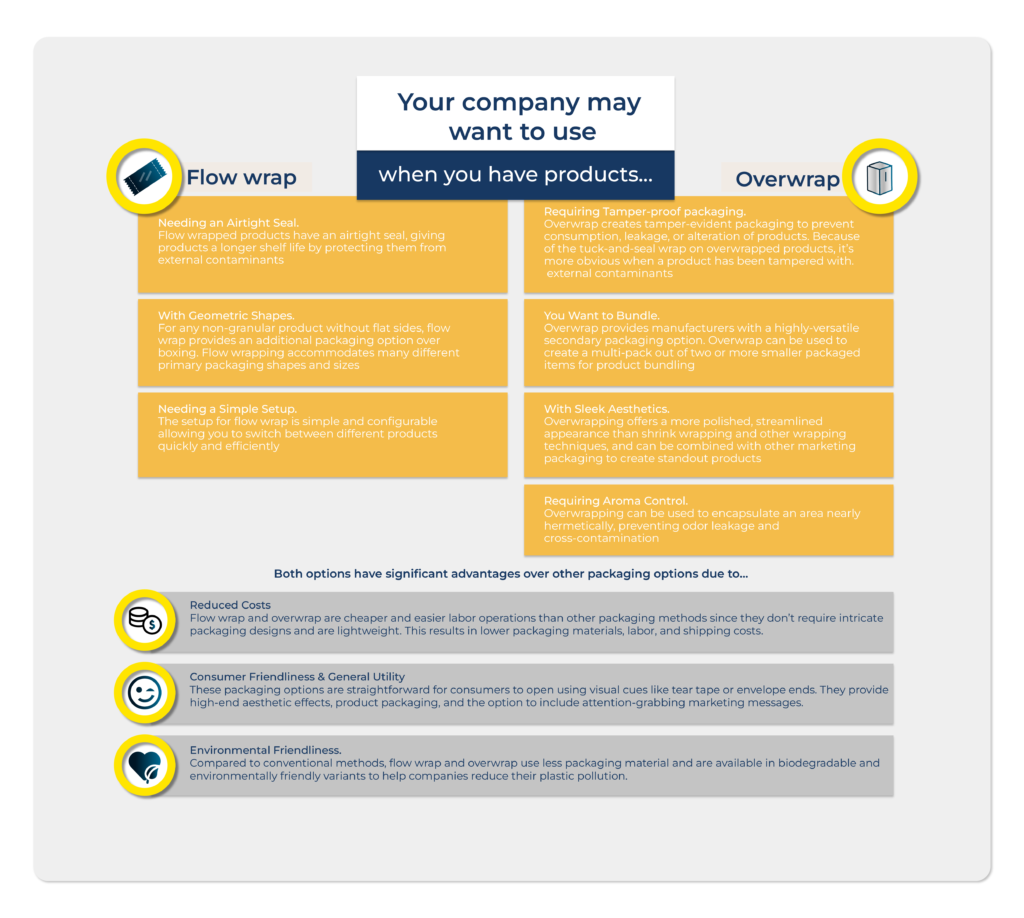
Overwrap Packaging Definition
Overwrap is a packaging method that wraps and heat-seals products with flat sides, such as cylinders and cube-shaped boxes. It uses flexible films to create a tuck-and-fold seal on boxes, cartons, and other flat-sided objects. Cigarette boxes, DVDs, and personal care items are just a few examples of things that are typically overwrapped.

Benefits of Overwrapping your Products
Overwrapping is suitable when adding secondary packaging over products that have already been sealed. It aids in preserving freshness and allows manufacturers to combine individually packaged products together in sets.
Benefits of overwrapping a product:
- Visual Appeal: The tuck-and-seal packaging that overwrap provides gives products a sleek look, adding to their appeal.
- Versatility: Because overwrap can be used as primary or secondary packaging, it’s a versatile packaging option that can add to a product’s aesthetics, protection, or in product bundling
- Anti-tampering: Overwrapped packages that have been tampered with are easily identifiable, as the seal can typically only be created by the overwrap machine and are virtually impossible to recreate without an overwrap machine.
When Should Overwrap Packaging Not Be Used?
There are a few reasons why overwrapping can be an issue:
- Cost: While still low cost compared to other packaging options, overwrap uses about 20% more film, resulting in costs that add up over time.
- Compatibility: Overwrap packaging might not be compatible with certain products depending on size, shape, and weight. This will obviously limit the range of products that can use this packaging method.
Why is Flow Wrap Sometimes Called Overwrap?
Flow wrap and overwrap are sometimes confused or referred to interchangeably because they share similarities in using a flexible film to enclose a product. However, they are technically distinct methods, and the overlap in terminology often comes from misunderstanding their applications or visual similarities. Here’s why the confusion arises:
Shared Features:
- Use of Flexible Film: Both methods involve wrapping products with a thin film, often transparent or printed.
- Protective Layer: Both provide a protective barrier against dust, moisture, and tampering.
- Consumer Goods Focus: Both are commonly used for packaging items like snacks, small products, or bundles.
Flow Wrap Is Sometimes Confused Overwrap Due To:
- Visual Similarity: The outer layer of film in flow wrapping can resemble the film used in overwrapping, especially when wrapped tightly around a product.
- Overlap in Applications: Both are often used for lightweight consumer goods, leading to interchangeable usage in casual discussions.
- Industry Terminology Variance: Different regions or industries may use “overwrap” as a broader term to describe various types of wrapping, including flow wrapping.
What Types Of Equipment Are Used in Overwrapping Vs Flow Wrapping?
Overwrapping Equipment
Overwrapping involves folding a film around a product and sealing it neatly, often resembling gift wrapping.
Key Equipment Used:
- Overwrapping Machines:
- These machines fold and seal film tightly around the product with precise edges.
- Types of Overwrapping Machines:
- Semi-Automatic Overwrappers: Require manual loading and adjustments but perform automated folding and sealing.
- Fully Automatic Overwrappers: Fully automate the process, ideal for high-volume operations.
- Heat Sealing Units:
- Used to seal the film edges by applying controlled heat and pressure.
- Ensures a tamper-evident and secure package.
- Cutting Mechanisms:
- Integrated blades cut the film to size based on the product dimensions.
- Conveyor Systems:
- Used to feed products into the machine in an orderly fashion.
- Ensures consistent spacing for smooth operation.
Film Materials Used:
- Biaxially Oriented Polypropylene (BOPP).
- Cellophane.
- Laminated films.
Flow Wrapping Equipment
Flow wrapping involves forming a continuous tube of film around a product, sealing it, and cutting it into individual packages.
Key Equipment Used:
- Flow Wrapping Machines (Horizontal Form-Fill-Seal Machines):
- Continuously wrap products in a horizontal motion.
- Equipped with forming collars to shape the film into a tube around the product.
- Suitable for high-speed operations.
- Sealing Units:
- Longitudinal Sealing Jaws: Seal the film along the length of the product (back seal).
- Cross-Sealing Jaws: Seal and cut the film between individual packs at the ends.
- Cutting Systems:
- Rotary or guillotine cutters separate the wrapped products at precise intervals.
- Conveyors:
- Feed products into the machine.
- Maintain alignment and spacing for consistent wrapping.
Film Materials Used:
- Polypropylene (PP).
- Polyethylene (PE).
- Heat-sealable laminated films.
| Aspect | Overwrapping | Flow Wrapping |
|---|---|---|
| Wrapping Style | Neat folds like gift wrapping. | Continuous tube of film. |
| Machine Complexity | Moderate; involves folding and sealing. | High; involves forming, sealing, and cutting. |
| Product Orientation | Static, often boxed. | Moves through horizontally. |
| Production Speed | Slower, suitable for premium items. | High-speed for mass production. |
| Typical Industries | Premium goods, boxed products. | Food, retail, and industrial sectors. |
Choosing the Right Equipment:
- Use Overwrapping Equipment if:
- You require a polished, premium appearance.
- The products are boxed or rigid.
- Use Flow Wrapping Equipment if:
- Speed and efficiency are crucial.
- Products are small, soft, or individually portioned.
How Much Is Spent on Flow Wrapping Vs Overwrapping Products Annually?
Flow Wrap Packaging Market:
The global flow wrap packaging market was valued at approximately USD 27.88 billion in 2024 and is projected to reach around USD 40.02 billion by 2030, growing at a compound annual growth rate (CAGR) of 5.3%. Virtue Market Research
Packaging Industry Overview:
The global packaging market is expected to reach USD 1.18 trillion by 2025, with a CAGR of 3.89%, and grow to USD 1.43 trillion by 2030. Mordor Intelligence
Estimating Overwrapping Market Size:
While specific figures for overwrapping are not readily available, we can infer that overwrapping constitutes a smaller segment of the overall packaging market compared to flow wrapping. Overwrapping is often used for premium products and boxed items, which represent a niche market within the broader packaging industry.
What Packaging Method Works Best for You?
The core elements of effective packaging design are contemporary aesthetics, dependable performance, and cost-effectiveness. Both wrapping approaches excel in these areas, but depending on the needs of your business and products, one method may be preferable. Refer to the table below when choosing the best option for your packaging needs.
| Your company may want to use | |
| Flow Wrap | Overwrap |
| when you have products… | |
| Needing an Airtight Seal. Flow wrapped products have an airtight seal, giving products a longer shelf life by protecting them from external contaminants. | Requiring Tamper-proof packaging. Overwrap creates tamper-evident packaging to prevent consumption, leakage, or alteration of products. Because of the tuck-and-seal wrap on overwrapped products, it’s more obvious when a product has been tampered with. |
| With Geometric Shapes. For any non-granular product without flat sides, flow wrap provides an additional packaging option over boxing. Flow wrapping accommodates many different primary packaging shapes and sizes. | You Want to Bundle. Overwrap provides manufacturers with a highly-versatile secondary packaging option. Overwrap can be used to create a multi-pack out of two or more smaller packaged items for product bundling. |
| Needing a Simple Setup. The setup for flow wrap is simple and configurable allowing you to switch between different products quickly and efficiently | With Sleek Aesthetics. Overwrapping offers a more polished, streamlined appearance than shrink wrapping and other wrapping techniques, and can be combined with other marketing packaging to create standout products. |
| Requiring Aroma Control. Overwrapping can be used to encapsulate an area nearly hermetically, preventing odor leakage and cross-contamination. | Both options have significant advantages over other packaging options due to… |
| Reduced Costs. Flow wrap and overwrap are cheaper and easier labor operations than other packaging methods since they don’t require intricate packaging designs and are lightweight. This results in lower packaging materials, labor, and shipping costs. | |
| Consumer Friendliness & General Utility. These packaging options are straightforward for consumers to open using visual cues like tear tape or envelope ends. They provide high-end aesthetic effects, product packaging, and the option to include attention-grabbing marketing messages. | |
| Environmental Friendliness. Compared to conventional methods, flow wrap and overwrap use less packaging material and are available in biodegradable and environmentally friendly variants to help companies reduce their plastic pollution. | |
